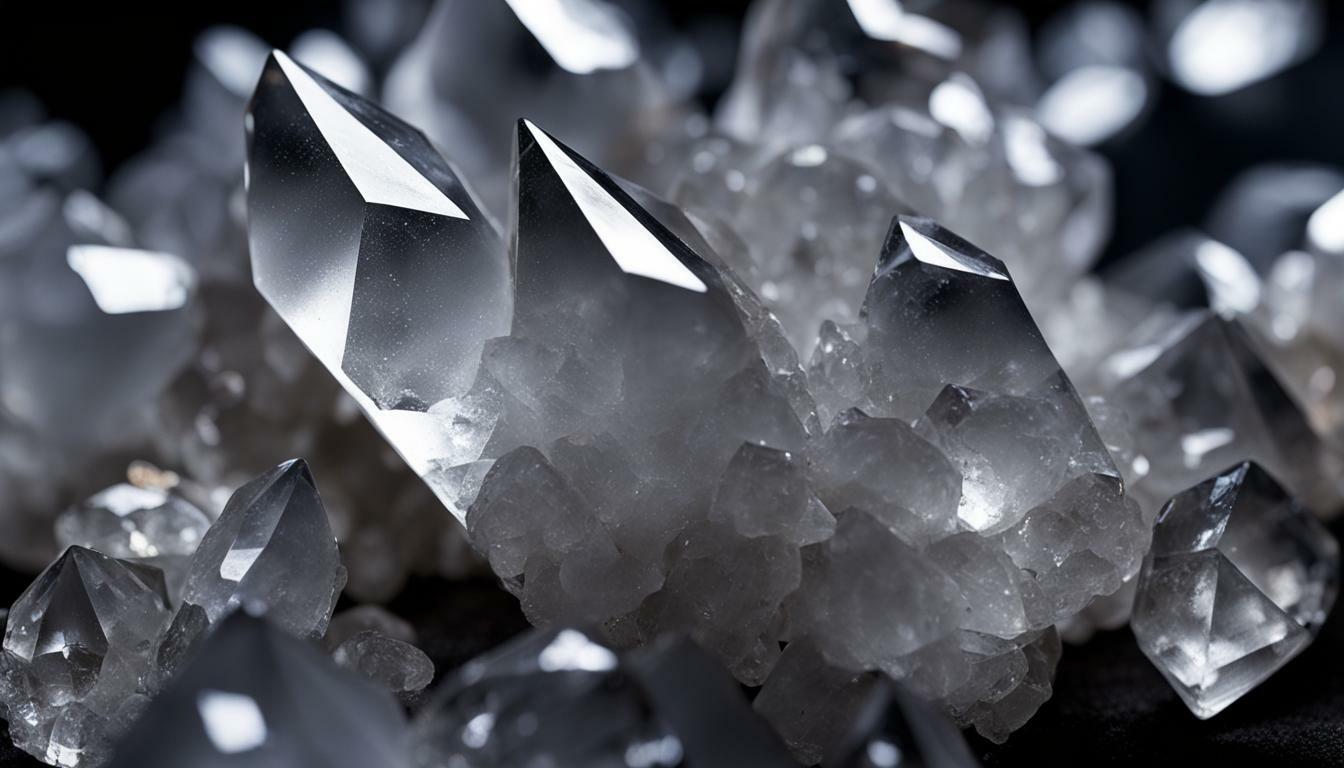Quartz crystals have a fascinating history that spans millions of years, and understanding their age is a key aspect of unraveling their mysteries. These unique minerals, composed of silica (silicon dioxide), are the second most abundant in the Earth’s continental crust. Quartz crystals exist in two forms, α-quartz and β-quartz, both of which are chiral. The transformation from α-quartz to β-quartz occurs at 573 °C.
Quartz crystals can be found in a variety of colors and are commonly used in jewelry and hardstone carvings. They are known for their hardness and durability, making them ideal for various applications. The word “quartz” comes from the German word “Quarzi,” and it has Slavic origins.
Quartz can be found in rocks of the Earth’s crust, with the largest amounts found in igneous rocks like granitoids. It can also be found in smaller amounts in sedimentary and metamorphic rocks. The silica content of rocks can vary, with quartz being a major component in some and absent in others.
The ability of quartz to vibrate at precise frequencies makes it useful in transmitting TV and radio signals. This property, along with its abundance, has made quartz a valuable mineral throughout history. It has been used in jewelry, as a healing stone, and even in technological advancements.
Quartz crystals have a Mohs hardness rating of 7, making them durable and resistant to scratching. They can encapsulate other minerals, such as rutile and tourmaline, adding to their beauty and uniqueness.
Key Takeaways:
- Quartz crystals are composed of silica and are the second most abundant mineral in the Earth’s continental crust.
- They exist in two forms, α-quartz and β-quartz, with a transformation occurring at 573 °C.
- Quartz crystals can be found in various colors and have been used in jewelry and hardstone carvings.
- Quartz is widely distributed in rocks of the Earth’s crust, with the largest amounts found in igneous rocks.
- Its ability to vibrate at precise frequencies makes it useful in transmitting TV and radio signals.
The Formation Process of Quartz Crystals
The formation process of quartz crystals is a remarkable journey that takes place over a significant period of time. Understanding this process can help us appreciate the beauty and uniqueness of these mesmerizing crystals. Quartz crystals are formed deep within the Earth’s crust, in igneous rocks such as granitoids. The formation begins with the cooling and solidification of magma, which contains silica-rich minerals.
Quartz crystals are formed through a process called crystallization, where the atoms arrange themselves in a repeating pattern to form a crystal lattice structure. This process can take millions of years.
During the cooling process, the magma undergoes a chemical transformation, allowing the silica-rich minerals to come together and form quartz crystals. As the magma cools further, the atoms arrange themselves in a repeating pattern to form a crystal lattice structure. This process, known as crystallization, can take millions of years.
As the quartz crystals continue to grow, they can encapsulate other minerals, such as rutile and tourmaline, creating fascinating inclusions within the crystal. The shape and size of quartz crystals can vary depending on the specific environmental conditions during their formation, including temperature, pressure, and the presence of other minerals.
Overall, the formation of quartz crystals is a complex and intricate process that showcases the wonders of nature. The beauty and durability of these crystals are a testament to the time and natural forces required to create them. Understanding the formation process allows us to appreciate the significance and value of quartz crystals in various aspects of our world, from their use in jewelry to their presence in technology and spirituality.
| Key Points: |
|---|
| The formation process of quartz crystals is a remarkable journey that takes place over a significant period of time. |
| Quartz crystals are formed through a process called crystallization, where the atoms arrange themselves in a repeating pattern to form a crystal lattice structure. |
| This process can take millions of years and is influenced by various environmental factors. |
| The beauty and durability of quartz crystals are a testament to the time and natural forces required for their formation. |
Uncovering the Age of Quartz Crystals: Crystal Dating Techniques
Scientists have developed sophisticated crystal dating techniques to determine the age of quartz crystals, offering valuable insights into their ancient origins. These techniques, collectively referred to as geochronology, rely on the principles of radioactive decay and the measurement of isotopic ratios to calculate the age of minerals.
One commonly used method is radiometric dating, which involves analyzing the decay of radioactive isotopes within quartz crystals. Different isotopes decay at different rates, providing a reliable clock for determining the age of a crystal. By measuring the isotopic ratios of certain elements, such as uranium and lead, scientists can calculate the time that has elapsed since the crystal formed.
Another technique used in crystal dating is thermoluminescence dating. This method takes advantage of the fact that quartz crystals store energy from ionizing radiation in their crystal lattice structure. When heated, this stored energy is released in the form of light. By measuring the intensity of this thermoluminescence, scientists can determine how long it has been since the crystal was last exposed to heat or sunlight, thus providing an estimate of its age.
In addition to these methods, researchers also utilize optically stimulated luminescence (OSL) dating, electron spin resonance (ESR) dating, and other specialized techniques to date quartz crystals. These techniques involve measuring the energy absorbed and released by the crystals under specific conditions, providing further insights into their age and geological history.
Crystal Dating Techniques at a Glance
| Method | Principle | Applications |
|---|---|---|
| Radiometric Dating | Measuring isotopic ratios and radioactive decay | Estimating the absolute age of quartz crystals |
| Thermoluminescence Dating | Measuring the energy released by heating | Dating crystals exposed to heat or sunlight |
| Optically Stimulated Luminescence (OSL) Dating | Measuring the energy absorbed and released by light | Dating crystals buried in sediment or soil |
| Electron Spin Resonance (ESR) Dating | Measuring the energy absorbed and released by electrons | Dating crystals containing trapped electrons |
These crystal dating techniques have revolutionized our understanding of the age and formation process of quartz crystals. By unlocking the secrets of these beautiful minerals, scientists can unravel the intricate geological history of our planet and gain valuable insights into Earth’s ancient past.
Significance of Quartz Crystals in Our World
Quartz crystals hold immense significance in our world, playing essential roles in jewelry design, technological advancements, and even spiritual practices. These beautiful crystals have captivated humans for centuries with their mesmerizing colors and unique properties.
In the realm of jewelry, quartz crystals are highly valued for their aesthetic appeal. From delicate pendants to statement rings, these crystals add a touch of elegance and sparkle to any piece. The wide range of colors and formations, such as amethyst and citrine, allows for endless creative possibilities in jewelry design. Whether it’s a cherished heirloom or a trendy accessory, quartz crystals continue to be a sought-after gemstone in the fashion industry.
Moreover, the significance of quartz crystals extends beyond their visual appeal. In the realm of technology, these crystals play a vital role in various devices. Quartz is widely used in electronic circuits due to its ability to generate a precise electrical charge. The piezoelectric properties of quartz crystals allow them to convert mechanical energy into electrical energy, making them essential components in watches, clocks, and even smartphones. The accuracy and reliability of quartz crystals have revolutionized the world of timekeeping and communication.
Not limited to the realms of fashion and technology, quartz crystals also hold spiritual significance for many cultures. Throughout history, these crystals have been regarded as powerful healing stones, believed to help balance energies and promote well-being. People use quartz crystals during meditation and energy healing practices to enhance spiritual connections and achieve a state of inner peace. The tranquil energy emitted by these crystals is believed to cleanse the mind, body, and soul.
| Significance of Quartz Crystals in Our World |
|---|
| Jewelry Design |
| Technological Advancements |
| Spiritual Practices |
“The wide range of colors and formations, such as amethyst and citrine, allows for endless creative possibilities in jewelry design.”
In conclusion, quartz crystals have an immense significance that transcends various aspects of our world. Whether adorning our bodies, powering our devices, or assisting in our spiritual journeys, these crystals continue to captivate and inspire us with their beauty and versatility.
Conclusion
In conclusion, understanding the age of quartz crystals sheds light on their fascinating history and their incredible value in different aspects of our lives. Quartz crystals, composed primarily of silica, are the second most abundant mineral in the Earth’s continental crust. Their unique formation process, which involves the transformation from α-quartz to β-quartz at 573 °C, contributes to their diverse colors and properties.
Crystal dating techniques, such as geochronology, allow scientists to determine the age of quartz crystals by analyzing the radioactive isotopes present in them. These techniques provide valuable insights into the geological history of the Earth and the processes that have shaped it over millions of years.
The significance of quartz crystals extends beyond their geological age. They have been prized throughout history for their beauty and durability, making them popular in jewelry and hardstone carvings. Additionally, quartz’s ability to vibrate at precise frequencies has made it essential in technology, where it is used in the transmission of TV and radio signals.
Furthermore, quartz crystals have held spiritual significance for many cultures, believed to have healing and energy-balancing properties. Their presence in various aspects of our world, from decorative jewelry to technological advancements and spiritual practices, highlights their enduring impact and versatility.
Does the Age of Quartz Crystals Affect Their Value?
The age of quartz crystals holds no direct impact on their value. Nevertheless, potential buyers may attribute a higher quartz crystal price to antique or rare specimens that have been naturally formed over long periods. However, the value of quartz crystals primarily revolves around factors like clarity, color, size, and overall aesthetic appeal.
FAQ
Q: How old are quartz crystals?
A: The age of quartz crystals can vary widely depending on the specific geological processes they have undergone. However, quartz crystals can be billions of years old, dating back to the formation of the Earth itself.
Q: What is the formation process of quartz crystals?
A: Quartz crystals are formed deep within the Earth’s crust through a combination of heat and pressure. This process typically takes place in areas where magma or hydrothermal fluids interact with existing rocks, allowing the silica to crystallize and form quartz.
Q: How is the age of quartz crystals determined?
A: The age of quartz crystals can be determined through various dating techniques, including radiometric dating and isotopic analysis. These methods involve measuring the ratios of certain isotopes within the crystal and comparing them to known decay rates to estimate their age.
Q: What is the significance of quartz crystals?
A: Quartz crystals have a wide range of significance in our world. They are commonly used in jewelry and hardstone carvings due to their beauty and durability. Additionally, quartz crystals have unique properties that make them valuable in technology, such as their ability to vibrate at precise frequencies, making them useful in transmitting TV and radio signals.
Q: Are quartz crystals commonly found in nature?
A: Yes, quartz crystals are one of the most abundant minerals in the Earth’s continental crust. They can be found in a variety of colors and are often present in rocks, particularly granitoids. Quartz crystals are widely distributed and abundant, making them a valuable and easily accessible mineral.








